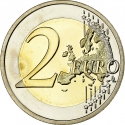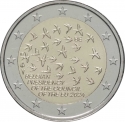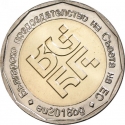You are about to finish your registration. Please check your mailbox (including spam folder). There should be a letter with a confirmation link. Check setting to make sure that your e-mail address is correct.
Send letter againDescription
The Presidency of the Council of the European Union is responsible for the functioning of the Council of the European Union, the upper house of the EU legislature. It rotates among the member states of the EU every six months. The presidency is not an individual, but rather the position is held by a national government. It is sometimes incorrectly referred to as the President of the European Union. The presidency's function is to chair meetings of the Council, determine its agendas, set a work programme and facilitate dialogue both at Council meetings and with other EU institutions.
The Hungarian Presidency of the Council took place during the first half of 2011, taking over from Belgium and passing it to Poland.
Engraver: Attila Rónay
Obverse

|
In the center, a wreath of twelve stars, representing the European Union, encircles the letters "EU." Converging towards the center, four lines diverge and three stripes form a gate-like frame. Positioned at the bottom of this frame is an image of the Hungarian Parliament building, set against the backdrop of the Danube. Along the upper circular border, the inscription "COUNCIL OF THE EUROPEAN UNION" is featured, while below it, the words "HUNGARIAN," "PRESIDENCY," and "2011" are arranged in horizontal rows. At the bottom center, the engraver's privy mark is situated. AZ EURÓPAI UNIÓ TANÁCSÁNAK |
|---|---|
Reverse

|
Depicts the stylized flag of the Republic of Hungary. Moving towards the center field, four lines and three stripes diverging from each other hold a frame. The year of issue, "2011" divides the frame. In the upper part, the denomination and the inscription "FORINT" are visible in horizontal rows below each other. In the lower part, the coat of arms of the Republic of Hungary is depicted, below which the mint mark "BP." is visible. The inscription "HUNGARIAN REPUBLIC" is placed in the upper circular border. MAGYAR KÖZTÁRSASÁG |
| Edge |







